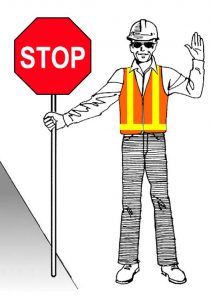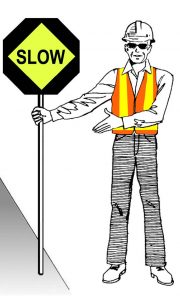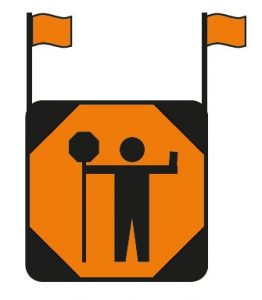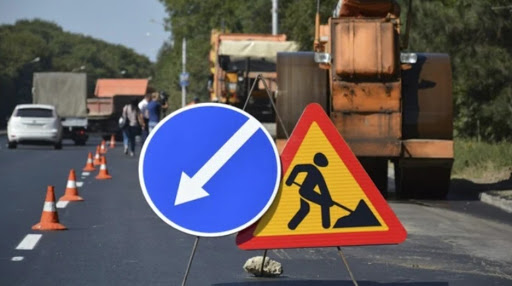Traffic Control – Public Roads 2
Traffic Control – Public Roads 2
Explain dangers
When construction or utility work affects traffic on public roads, there’s a risk both to workers and to ordinary drivers and passengers.
The first priority of a traffic control person (TCP) is to protect workers and the public from accident and injury.
Identify controls
In addition to the hard hats and safety boots you’re already wearing, you’re going to need some equipment to do traffic control:
• A safety vest that meets the requirements of the Construction Projects regulation (213/91, s. 69.1) and CSA standard.
• Eye protection—it’s dusty and bright out there
• A STOP/SLOW sign that meets requirements of the construction regs (213/91, s. 68).
If working after dark, TCPs must wear clothing with retroreflective silver stripes encircling each arm and leg. It’s also good practice to have reflective tape on your hard hat, use a flashlight with a red cone attachment, and place flashing amber lights ahead of your post.
Demonstrate
[Using the STOP/SLOW sign, demonstrate the following as you talk.]
Here’s how to use the STOP/SLOW sign.
• When you show the STOP side to approaching traffic, hold up your free hand like this.
• Hold the sign firmly in view of oncoming traffic.
• Give motorists plenty of warning. Don’t suddenly flash STOP when a driver is too close.

• When you show STOP, clearly indicate where you want traffic to stop. When traffic has stopped, you may move to a point on the road where traffic in that lane can see you.
• When you show the SLOW side, motion traffic to keep moving slowly. Don’t bring traffic to a complete halt. When drivers slow down, use your free hand to signal them to keep moving slowly.
• Make sure that the STOP-SLOW sign is clean, undamaged, and meets height and size requirements.
• If you’re working along a two-lane road with traffic moving in both directions, you’ll have to coordinate your signals with the TCP on the other side.

• Where two lanes are reduced to one, make sure you stop traffic in one direction before letting traffic through from the other direction.
• Coordinate your efforts with nearby traffic signals to avoid unnecessary delays, tie-ups, and confusion.
• Place the TRAFFIC CONTROL PERSON AHEAD sign at a distance that gives motorists adequate warning of your upcoming presence.

For more information, visit the IHSA website.

